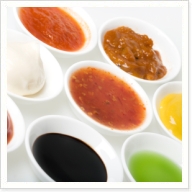
If you’ve been wondering about MSG and its effects on health, read on for some interesting facts.
What is MSG?
MSG stands for “Monosodium Glutamate” and is made of water, sodium and glutamate. Glutamate is an amino acid that is used to make proteins in food and our body.
MSG doesn’t have a specific flavour of its own. Instead, MSG is used as an ingredient to enhance the natural flavours of foods such as meat, poultry, soups, stews, casseroles, gravies, seafood, snacks and vegetable dishes.
Glutamate itself if also found naturally in foods such as corn, green peas, mushrooms and tomatoes.
Is MSG the same as salt?
No. MSG is made from water, sodium and glutamate. Table salt is made from sodium and chloride.
Is MSG safe to eat?
Yes. According to Health Canada, MSG is not a health hazard.
But some people may have a sensitivity to MSG. It is the glutamate part of MSG that can produce symptoms such as:
-
Blurred vision
-
Tingling and/or burning sensation
-
Chills and shakes
-
Feeling of pressure on the face
-
Headache
-
Increased heartbeat
-
Nausea and vomiting
-
Pain in the face, back, neck or chest
These common symptoms of MSG sensitivity are generally temporary and can appear about 20 minutes after eating MSG and last for about two hours. The symptoms seem to happen faster and are more severe if you eat MSG-containing foods on an empty stomach or drink alcohol at the same time.
Note: Do not automatically assume that you have a sensitivity to MSG if you experience any of these symptoms. Check with your doctor to make sure that you do not have another condition or allergy that might be causing these symptoms.
Is there a link between MSG and migraine headaches? What about asthma?
There is not enough research to prove whether MSG triggers migraine headaches. If you find that you tend to get a migraine after eating MSG, the best advice is to avoid eating MSG-containing foods.
Some people say they feel symptoms of asthma after eating MSG. These symptoms may occur one to two hours after eating MSG or even up to 12 hours after eating it.
If you frequently experience migraines or symptoms of asthma, talk to your doctor.
Which foods contain MSG or glutamate?
|
corn
green peas
grapes
grape juice
|
mushroom
some cheeses (Parmesan and Roquefort)
tomatoes
tomato juice
|
Pre-packaged foods that contain monosodium glutamate:
|
Bottled and canned sauces
Canned meats
Condiments
Cookies and crackers
Croutons
Cured meats
Diet foods
|
Dry soup mixes
“Flavour packages” in boxed entrées
Freeze-dried foods
Frozen foods
Gravy and seasoning mixes
Potato chips
|
Prepared dinners and side dishes
Prepared salads, salad dressings and mayonnaise
Prepared snacks
Smoked meats and sausages
Soups (canned, dried, bouillon)
Spices and seasonings
|
Flavourings
|
Accent
Ajinomoto
Chinese seasoning
Glutacyl
Glutavene
Gourmet powder
Hydrolysed plant protein (HPP)
Hydrolysed vegetable protein (HVP)
|
Kombu extract
Mei-jing
Natural flavourings (may be HVP)
RL-50
Subu
Vetsin
Wei-jing
Zest
|
How can I tell if a food contains MSG?
“Monosodium Glutamate” must always be stated on the list of ingredients whenever it is added to a pre-packaged food. MSG is usually added in small amounts, so you’ll find it towards the end of the ingredients list (because ingredients are listed in descending order of the amount present in the food).
If the MSG is part of a spice or other ingredient used in the food, it must still be declared on the list of ingredients.
Be careful with imported products. The ingredients lists on imported products are not always translated accurately. Try to buy foods made in Canada or USA where MSG must always be listed on the label.
Last Update – June 8, 2020